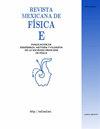Ground state energy of the hydrogen atom inside penetrable spherical cavities; variational approach
Q4 Social Sciences
引用次数: 0
Abstract
In this work we calculate the ground state energy of the hydrogen atom confined in a sphere of penetrable walls of radius Rc. Inside the sphere the system is subject to a Coulomb potential, whereas outside of it the potential is a finite constant V0. The energy is obtained as a function of Rc and V0 by means of the Rayleigh-Ritz variational method, in which, the trial function is proposed as a free particle wave function within a finite square well potential but including an exponential factor that takes into account the electron-nucleus Coulomb attraction. For an impenetrable sphere, , the energy grows fast as Rc approaches zero. On the other hand, when the height of the barrier V0 is finite, the energy increases slowly as Rc goes to zero. We also compute the Fermi contact term, nuclear magnetic screening, polarizability, pressure and tunneling as a function of Rc and V0. As expected, these physical quantities approach the corresponding values of the free hydrogen atom as Rc grows. We also discuss the pressure-induced ionization of the hydrogen atom. The present results are found in good agreement with those previously published in the literature.可穿透球腔内氢原子的基态能;变分方法
在这项工作中,我们计算了氢原子被限制在半径为Rc的可穿透壁的球体中的基态能量。在球内,系统受库仑势的作用,而在球外,系统受库仑势的作用是一个有限常数。利用瑞利-里兹变分方法得到了能量作为Rc和V0的函数,其中,试验函数被提出为有限平方势内的自由粒子波函数,但包含考虑电子-核库仑吸引的指数因子。对于一个不可穿透的球体,当Rc接近零时,能量增长很快。另一方面,当势垒V0的高度有限时,当Rc趋于零时,能量缓慢增加。我们还计算了费米接触项、核磁屏蔽、极化率、压力和隧道效应作为Rc和V0的函数。正如预期的那样,随着Rc的增长,这些物理量接近于自由氢原子的相应值。我们还讨论了压力诱导的氢原子电离。本研究结果与先前发表的文献一致。
本文章由计算机程序翻译,如有差异,请以英文原文为准。
求助全文
约1分钟内获得全文
求助全文
来源期刊

Revista Mexicana De Fisica E
社会科学-科学史与科学哲学
CiteScore
0.80
自引率
0.00%
发文量
14
审稿时长
>12 weeks
期刊介绍:
The Revista Mexicana de Física (Rev. Mex. Fis.) publishes original papers of interest to our readers from the physical science com unity. Language may be English or Spanish, however, given the nature of our readers, English is recommended. Articles are classified as follows:
Research. Articles reporting original results in physical science.
Instrumentation. Articles reporting original contributions on design and construction of scientific instruments. They should present new instruments and techniques oriented to physical science problems solutions. They must also report measurements performed with the described instrument.
Reviews. Critical surveys of specific physical science topics in which recent published information is analyzed and discussed. They should be accessible to physics graduate students and non specialists, and provide valuable bibliography to the specialist.
Comments. Short papers (four pages maximum) that assess critically papers by others authors previously published in the Revista Mexicana de Física. A comment should state clearly to which paper it refers.
 求助内容:
求助内容: 应助结果提醒方式:
应助结果提醒方式:


